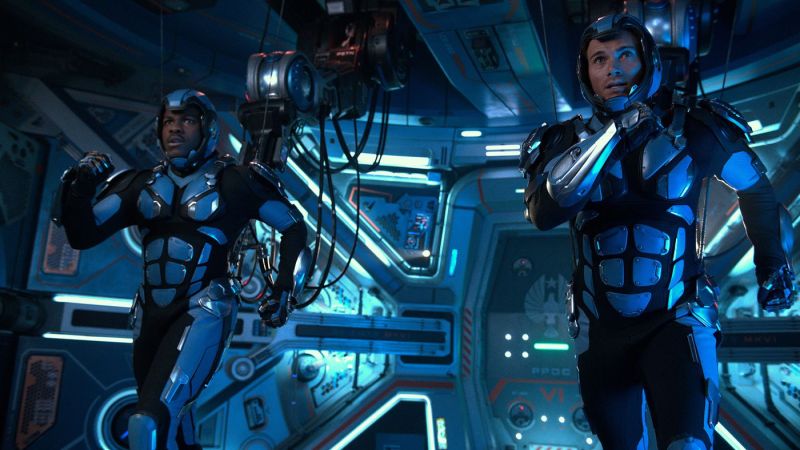In some ways, “Pacific Rim: Uprising” is a beast as bizarre as the first. The original “Pacific Rim” was a movie thoughtfully designed to feel stupid. Its more brilliant choices blended into the background, hiding like an unnoticed picture frame and highlighting the thrilling action. It was the movie “Transformers” wanted to be, but never was. Director Steven S. DeKnight has deftly picked apart the formula of the original, carefully reassembling it in “Uprising.” But in the process, something was lost. While “Uprising” largely succeeds, its most important component, its action, has fallen to the wayside, and this massive, lumbering robot of a movie never quite finds its legs.
Nevertheless, its successes are impressive. “Uprising” understands that story was never an important part of the original; the entirety of the first “Pacific Rim” is summarized in a 30 second montage at the start. DeKnight never feels like he takes himself seriously, nor does he allocate undue time to irrelevant details and characters. Instead, like the first movie, he uses easily-understood archetypes to create audience connection without the need for long, pointless scenes of dialogue. The strategy works; these new-to-the-franchise characters are generic and predictable, but still charming enough to carry the action. John Boyega, in particular, (whose character-archetype is the familiar rogue always shouting “I’m not my father!”) throws himself into his role with far more dedication than “Uprising” needs or wants.
Trying to explain the film’s plot is like trying to explain a dream. To put its chaos of creatures, robots and machismo in words would be to render it utterly incomprehensible, yet during the experience it all appears to have some bizarre form of consistency. The premise is simple enough: giant robots called Jaeger fight giant monsters called Kaiju. But then everything starts to spiral into a fevered hallucinatory experience — brains in tanks, mind melding, and a giant mace made out of a floating ball of cars all make their elegant entrances and exits. Once again the “Pacific Rim” franchise proves itself to be the anti-”Transformers.” While the latter will spend (literal) hours trying to hash out the details of pointless jargon like “allspark” and “transformium,” one of “Uprising”’s characters more or less says “Kaiju blood explodes!” and leaves it at that. A ridiculous premise calls for a ridiculous plot, and “Pacific Rim: Uprising” fully delivers.
That ridiculousness is yet another part of the original’s DNA that “Uprising” perfectly replicates. Though the Jaeger might look a bit more like toys this time around, their colorful multi-story-high chassis are still awe-inspiring on a theater screen. The Kaiju, with their inexplicable bony protrusions and bizarre bioluminescence, are equally as inspired.
But while “Uprising” nails these peripheral components, it ultimately fails on its biggest selling point. This is a blockbuster, after all, yet its action is somehow the only area that falls flat. Its battles occur almost exclusively in same-looking cities (Sydney and Tokyo are, with the exception of a few holographic advertisements in the latter, indistinguishable) amidst dull, perfectly sunny weather. The original’s action was complemented by its sheer beauty. The flawless cinematography highlighted the unique color palette and feel of the locations. “Uprising,” by comparison, looks stylistically identical to every other forgettable blockbuster since the dawn of CGI.
Luckily DeKnight understands that to stand apart from its predecessor, the premises behind “Uprising”’s setpieces have to turn the “wow” factor up to eleven, but that understanding doesn’t translate into execution. Of the film’s three major fight scenes, two are nothing but disappointing. One pits Jaeger against Jaeger, but instead of taking advantage of their creative weaponry, the scene resorts to standard movie-fight choreography, playing out like an everyday fistifight at 20 stories tall. The other combines Jaeger and Kaiju into a Cthulian Frankenstein, but the inventive visual concept is wasted on the mandatory “good guys lose in the second act” scene that has been the norm for blockbuster pacing since the original “Star Wars” trilogy.
Only the third, final battle, reaches its full potential. To explain its premise would be to spoil the movie’s biggest delight, but let it be said that it’s so ludicrous, so bombastic, that it could only reasonably have been generated in the mind of a four-year-old as he breaks, smashes, throws and recombines his action figures with no regard for logic or physics. It is unthinkable in its unpredictability, illustrious in its immaturity and it is glorious.
Only in this final scene does “Pacific Rim: Uprising” capture the fun, stupid purity that defined the original. Ultimately, its other well-executed aspects set the film up for high-quality action that takes far too long to arrive. Faced with the competition of “Ready Player One,” it will be a shame to see “Pacific Rim: Uprising” flop. It was so painfully close to finding del Toro’s greatness, but, like its lumbering robots, “Pacific Rim: Uprising” is only a hollow shell.
Contact Noah Howard at noah364 ‘at’ stanford.edu.
